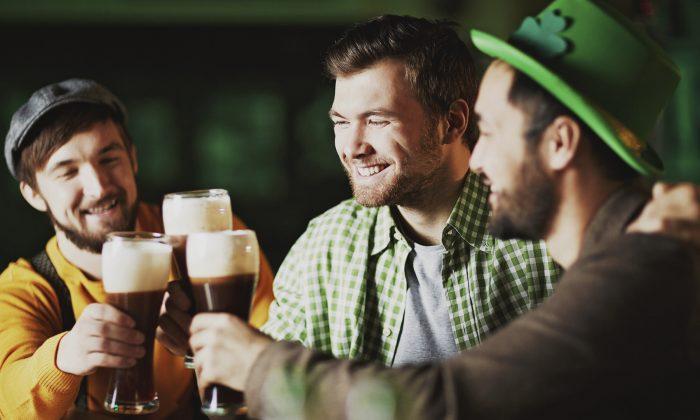There are two world famous symbols of Irish culture: St. Patrick’s Day, and the Irish pub—both synonymous with drinking and “good craic.” But history tells us that these icons of Irish identity were first conceived far away from Ireland. Since then, these phenomena have become a tangle of mythology, religion and politics; inseparable from—but hardly authentic to—the modern nation.
In fact, the first celebration of St. Patrick—patron saint of Ireland—was organized in Boston by members of the Charitable Irish Society, in 1737. The original society rules made the organization exclusively Protestant, and other early celebrations were also organized by Protestant officers in the British Army.
St. Patrick’s Day really increased in profile during the era of mass emigrations which began in the 19th century. It gradually became a celebration of what it means to be Irish in North America.

As the number of Catholics moving to North America increased after the Great Hunger, St. Patrick’s Day celebrations also became a demonstration of the increasing social and political power of Catholic Irish Americans. The celebrations were as varied as the emigrants themselves: middle-class dinner societies existed cheek-by-jowl with drunken, riotous street celebrations.
Wearing the Green
At the start of the 20th century, the “wearing of the green” had spread as far as New Zealand, and the celebration was considered necessary to maintain good spirits among the colonists. By contrast, St. Patrick’s Day in Ireland was a relatively sober affair until quite recently. It was not until 1903 that it became an official holiday, and for decades it was a day of holy observance and reflection. Dublin didn’t have its first parade until 1931, and pubs were closed on St. Patrick’s Day until the 1970s.
But St. Patrick’s Day hasn’t always brought people together. In fact, it has long concealed many of the divisions within the Irish diaspora. People who did not conform to religiously conservative Irish American society were ignored or excluded. For instance, the Irish Lesbian and Gay Organization was barred from marching in official St. Patrick’s Day parades in New York until this year.
What’s more, in Britain, sporadic outbreaks of violence during “the Troubles“—a bloody, 30-year ethno-nationalist conflict—made St. Patrick’s Day a topic of contention from the late 1960s onward. It wasn’t until the 1980s that St. Patrick’s Day became visible in the U.K. once more, and in 2002 London launched its annual festival in Trafalgar Square.
This process has marked the re-acceptance of Irish culture both in Britain and abroad—partly due to the success of Riverdance, boy bands such as Boyzone and Jedward and the twin absurdities of Father Ted and Mrs. Brown’s Boys.
Scholars have noted that, instead of holding up a mirror to the Irish, St. Patrick’s Day depicts them as they wished to be seen—congenial, convivial, public spirited, and united. Multi-national corporations picked up on this, and saw an opportunity to capitalize on “Brand Ireland.” Their weapon of choice? The Irish-themed pub.
Commercial Craic
Rather than recreating the traditional Dublin alehouses so vividly captured by James Joyce in Ulysses, Irish-themed pubs were conceived to “commodify the craic,“ and packed with affectations borrowed from Irish America’s fevered perception of the ”old country.“ The upside down bikes, signposts to obscure towns, and pictures of gap-toothed alcoholics and red-haired colleens you‘ll see in ”O’Malley’s“ and ”Flanagan’s” are about as Irish as Tom Cruise in “Far and Away.”
In particular, Guinness saw the development of the Irish-themed pub on the global stage as a means of greatly increasing consumption of its products which—after the 1997 merger that created the parent company, Diageo—also included Smirnoff vodka and Johnnie Walker scotch whisky. Not exactly “authentic” Irish fare.

In the 1990s, the Irish-themed pub became a presence on British high streets and city centers. Pub chains were suffering from falling numbers of drinkers, who were alienated by the cavernous cathedrals to the video juke box, live sport, and insipid lager. Guinness and others introduced reproductions of Irish pubs, hoping to bring a distinctive ethnic experience to stagnant high streets.
Today, most Irish pubs have little to do with Irish culture, and compete with traditional bars in more than 53 countries around the world. By seeking to sell the same “authentic” cultural experience all around the world, Irish pubs achieve just the opposite.
Despite this humbuggery, denizens of Irish pubs will still seek out “the craic” on March 17, in celebration of a Welsh man known for chasing snakes out of a country which never had any in the first place. The Irish are famous for their myth-making, and the legends behind St. Patrick’s Day and the Irish pub are some of the best yet. Sláinte!
Paddy Hoey is a lecturer in media at Edge Hill University in the U.K. David Shaw is a Ph.D. candidate at the University of Liverpool in the U.K. This article was originally published on The Conversation.


Friends Read Free